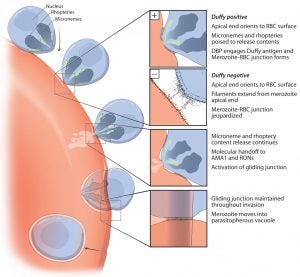Three gene mutations appear to be invasion mechanisms
 Researchers at Case Western Reserve University and Cleveland Clinic Lerner Research Institute have discovered recent genetic mutations in a parasite that cause more than 100 million cases of malaria annually—changes that may render tens of millions of Africans who had been considered resistant, susceptible to infection.
Peter A. Zimmerman, professor of international health, biology and genetics at the Case Western Reserve School of Medicine, and David Serre, a scientific staff member of the Genomic Medicine Institute at Lerner and assistant professor of genomics at Case Western Reserve, reported their findings at the American Society of Tropical Medicine and Hygiene annual meeting Nov. 15.
They and fellow researchers describe the changes in the Plasmodium vivax genome in papers scheduled to be published in the journal PLoS Neglected Tropical Disease on Nov. 21 and Dec. 5.
To learn the functions of the mutations, and whether the parasite is evolving around a natural defense, Zimmerman and Serre have received a $3.5 million grant from the National Institute of Allergy and Infectious Disease at the National Institutes of Health. They will begin their field study in early 2014.
“We’ve found a duplication of a gene known to enable the parasite to infect red blood cells and two possible additional components to a more complex red cell invasion mechanism,” Zimmerman said
Researchers have long thought P. vivax infects a person one way: A protein on the parasite, called the Duffy binding protein, latches onto a Duffy receptor on the surface of the person’s red blood cell and works itself through the membrane. People who lack the receptor are called Duffy negative and are resistant to infection.
But, during the last decade, reports of cases of Duffy negative patients with P. vivax infections have been on the rise in several parts of the world.
P. vivax has been called benign malaria because it is less lethal than malaria caused by Plasmodium falciparum. But unlike its cousin, P. vivax can hide from treatment in a host’s liver and repeatedly emerge to cause relapses of debilitating headaches, nausea and fever. This chronic malaria often triggers a cycle of poverty for sufferers left unable to work for long periods. By weakening the immune system, the disease contributes to death.
The Malaria Atlas Project estimates 2.5 billion people worldwide are at risk for P. vivax malaria.
Researchers at Case Western Reserve University and Cleveland Clinic Lerner Research Institute have discovered recent genetic mutations in a parasite that cause more than 100 million cases of malaria annually—changes that may render tens of millions of Africans who had been considered resistant, susceptible to infection.
Peter A. Zimmerman, professor of international health, biology and genetics at the Case Western Reserve School of Medicine, and David Serre, a scientific staff member of the Genomic Medicine Institute at Lerner and assistant professor of genomics at Case Western Reserve, reported their findings at the American Society of Tropical Medicine and Hygiene annual meeting Nov. 15.
They and fellow researchers describe the changes in the Plasmodium vivax genome in papers scheduled to be published in the journal PLoS Neglected Tropical Disease on Nov. 21 and Dec. 5.
To learn the functions of the mutations, and whether the parasite is evolving around a natural defense, Zimmerman and Serre have received a $3.5 million grant from the National Institute of Allergy and Infectious Disease at the National Institutes of Health. They will begin their field study in early 2014.
“We’ve found a duplication of a gene known to enable the parasite to infect red blood cells and two possible additional components to a more complex red cell invasion mechanism,” Zimmerman said
Researchers have long thought P. vivax infects a person one way: A protein on the parasite, called the Duffy binding protein, latches onto a Duffy receptor on the surface of the person’s red blood cell and works itself through the membrane. People who lack the receptor are called Duffy negative and are resistant to infection.
But, during the last decade, reports of cases of Duffy negative patients with P. vivax infections have been on the rise in several parts of the world.
P. vivax has been called benign malaria because it is less lethal than malaria caused by Plasmodium falciparum. But unlike its cousin, P. vivax can hide from treatment in a host’s liver and repeatedly emerge to cause relapses of debilitating headaches, nausea and fever. This chronic malaria often triggers a cycle of poverty for sufferers left unable to work for long periods. By weakening the immune system, the disease contributes to death.
The Malaria Atlas Project estimates 2.5 billion people worldwide are at risk for P. vivax malaria.




